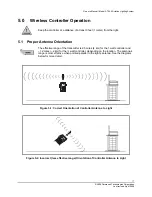
Owner’s Manual | Model A704-5 Aviation Lighting System
11
© 2008 Carmanah Technologies Corporation
Last revised: April 2008
4.3.2 Push Button Operation
The two types of button presses that will be accepted by the light as programming commands are:
Hold:
Pressing and holding the button down for several seconds cycles through the Model A704-5
command levels (see
Table 4-1: Overview of Command Levels and Modes
). Each
command level is indicated by the number of flashes from the amber indicator LED; one
blink indicates the first level, two blinks indicates the second level, etc. The amber indicator
LED indicates acceptance of a command for a button hold by flashing one to five times
depending on the command level. Once the desired command level has been reached,
release the push button.
Press:
Pressing the button for a fraction of a second enters the command within that level. The
green indicator LED indicates acceptance of a button press by flashing the same number of
times afterwards. The red indicator LED flashes three times if the command has not been
accepted due to button lockout. You must press the push button within 10 seconds of
releasing the hold, otherwise the light will exit the Programming Mode.
Table 4-1: Overview of Command Levels and Modes
illustrates the order of commands and modes for
programming the Model A704-5. This table is followed by a description of the light’s operation in each
mode. Read this table from left to right.
Table 4-1: Overview of Command Levels and Modes
Step 1: Choose Command Level
Step 2: Choose Command – Action (Response)
Command
Level
1 press
(1 Green
Indicator LED
Flash)
2 presses
(2 Green
Indicator LED
Flashes)
3 presses
(3 Green
Indicator LED
Flashes)
4 presses
(4 Green
Indicator LED
Flashes)
5 presses
(5 Green
Indicator LED
Flashes)
(No Amber
Flash)
0: Autonomous
Standby
Mode
2
Autonomous
Low
Autonomous
Med
Autonomous
High
Flash Toggle
(1 Amber
Flash)
1: Temporary
Temp Low
Temp Med
Temp High
No action
No action
(2 Amber
Flashes)
2: Ship
Ship Mode
Do Not Use
3
Do Not Use
4
No action
No action
(3 Amber
Flashes)
3: Infrared
Infrared
Toggle
No action
No action
No action
No action
(4 Amber
Flashes)
4: Diagnostics
Battery
Check
UCS Status
No action
No action
No action
(5 Amber
Flashes)
5: Configuration
No action
Button Lock
Toggle
Temp
Timeout
Toggle
No action
Factory
Reset
2
If the light is switched directly from Standby Mode to Autonomous mode, the light will remain off until the next time it detects a day-
to-night transition. When this is done in low lighting conditions such as an office or warehouse, the light will NOT turn on because
it considers it to be nighttime and is awaiting the next day-to-night transition before illuminating. If you would like to force the light to
turn on in Autonomous mode to verify the light illuminates, place it in a Temporary mode first and then into an Autonomous
mode. The light will now illuminate immediately in low lighting conditions.
3
For engineering test purposes only. Use may result in unpredictable behavior of the light.
4
For engineering test purposes only. Use may result in unpredictable behavior of the light.












































